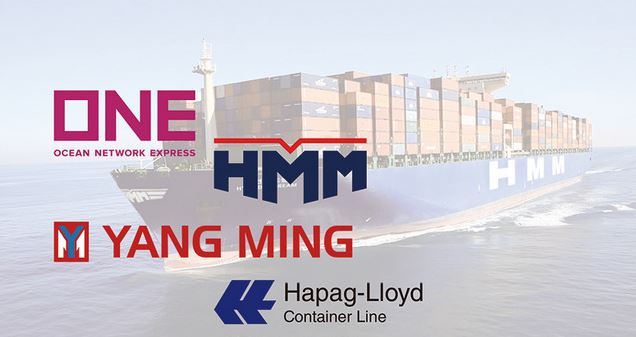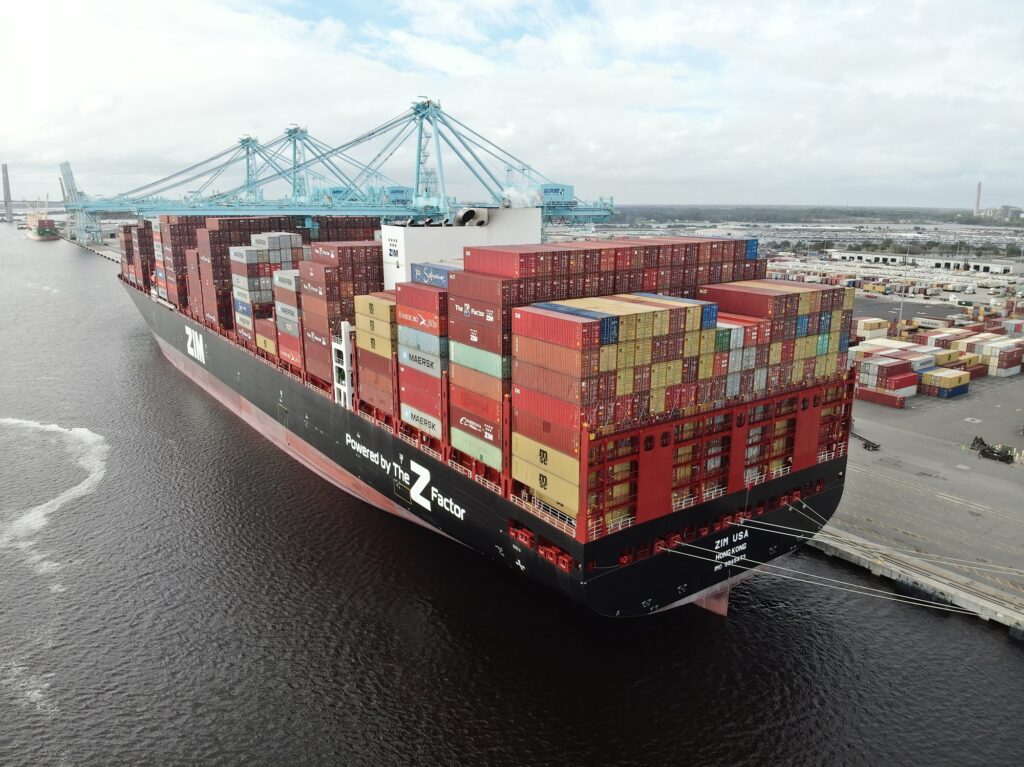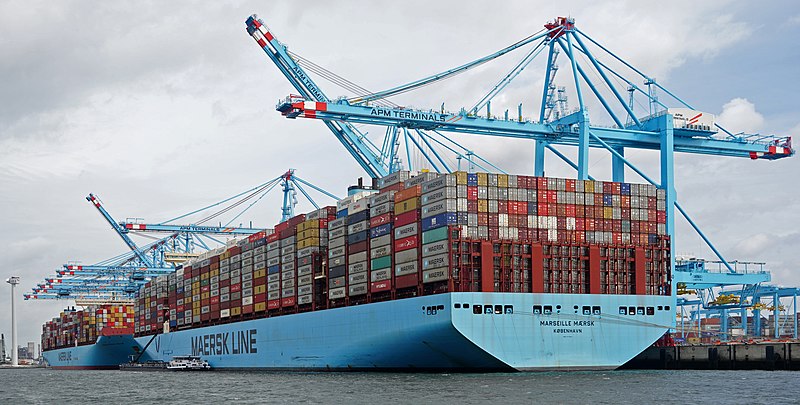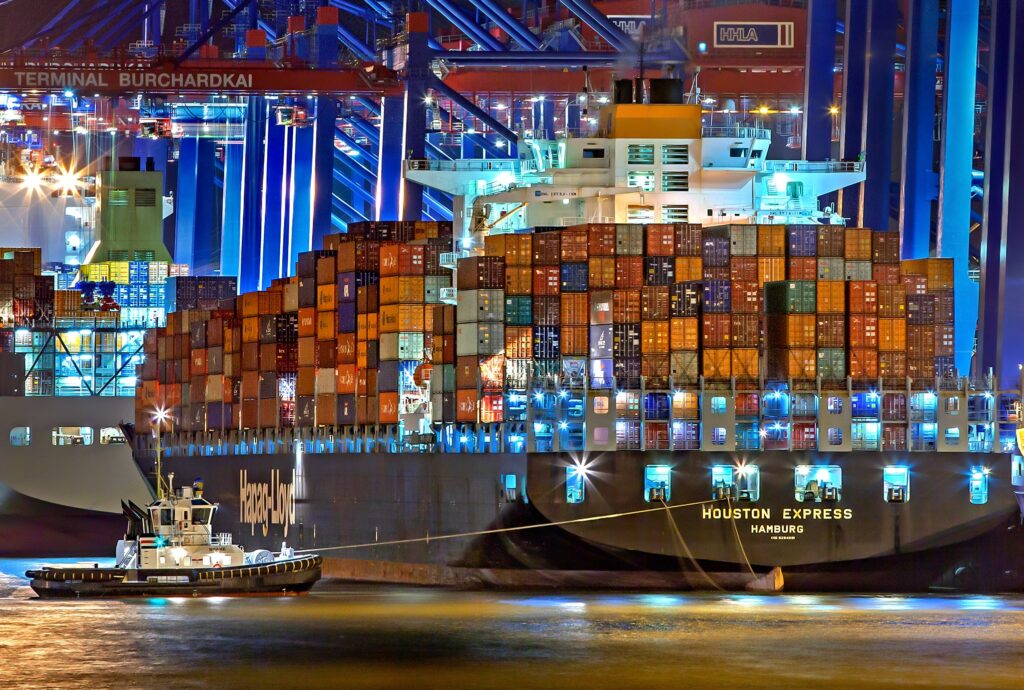El cargo The Alliance temporarily suspends flight 1 between North America and the West Coast. apareció primero en Logistika.
]]>
The Alliance, a strategic shipping partnership group consisting of four companies, including Korea’s HMM, Japan’s Ocean Network Express (ONE), Taiwan’s Yang Ming Shipping, and Germany’s Hapaakreut, announced that it will reorganize the Asia-North America West Coast route from October 8. A total of two services, including PN3 and PN2, will be reorganized. PN3 service will be suspended for the time being from October 8th. It is a route that goes around Hong Kong-Yantian-Shanghai-Busan-Vancouver-Tacoma-Busan-Kaohsiung. Instead, the PN2 service will be reorganized from October 12 by adding new ports of call such as Busan, Kaohsiung, Hong Kong, and Shanghai (Yangsan). The newly refined PN2 rotation is Singapore-Laem Chabang-Cai Mep-Haiphong-Yantian-Shanghai-Busan-Vancouver-Tacoma-Tokyo-Kobe-Kaohsiung-Hong Kong-Singapore. An official from The Alliance said, “Considering the current shipping market situation, we plan to temporarily suspend PN3 and strengthen PN2 until further notice.”
EXCERPT FROM KSG News, Mr.Choi reporter
El cargo The Alliance temporarily suspends flight 1 between North America and the West Coast. apareció primero en Logistika.
]]>El cargo ZIM to start Asia-WCSA service apareció primero en Logistika.
]]>Branded ZIM ‘Albatross’ service (ZAT), the new line will call at Xingang, Qingdao,
Shanghai, Ningbo, Pusan, Lazaro Cardenas, Buenaventura, Guayaquil, Callao, San Antonio,
Pusan, Xingang. A fleet of nine vessels, whose size has yet to be specified, is expected to be
used on the loop. ZIM has so far not announced when the ‘ZAT’ will kick off.
The ’ZAT’ will be ZIM’s first direct service between Asia and the West Coast of South
America. It will complement the carrier’s coverage of South America from Asia, which so far
is restricted to the East Coast of South America.
On the Asia-ECSA route, ZIM operates its ‘ASE’ weekly service, operated jointly with
Maersk and also takes slots on the North China-Brazil leg of COSCO
SHIPPING Specialized Carriers’ China-ECSA multi-purpose service

EXCERPT FROM ALPHALINER NEWS
El cargo ZIM to start Asia-WCSA service apareció primero en Logistika.
]]>El cargo Neo-panamax vessels spread to North-South trades apareció primero en Logistika.
]]>service in the course of 2023. These ships represent a capacity of 928,000 teu or 39% of all
new teu slots being added to the fleet this year.
Nineteen of these new neo-panamaxes have already joined Asia – North America services
(seven on the Transpacific and twelve in Asia—USEC loops), representing 30.1% of this
years’ new NPX capacity.
Thirteen others are now trading between Asia and Europe (nine to the Med and four to North
Europe). They account for 21.6% of this years’ NPX newbuildings. This brings the total for
East-West routes to 51.7%.
Fifteen ships (23.9%) have been assigned to North-South services from Asia to Latin
America (nine ships), Africa (three) or the Middle East and the Indian Subcontent (three).
The percentage of new NPX capacity assigned to North-South services is expected to further
increase as fifteen yet-to-be-delivered newbuildings (24.4%) have not appeared in sailing
schedules yet. Ship names as CMA CGM BAHIA or COSCO SHIPPING BRAZIL however
suggest that these vessels will likely end up in Asia – Latin America loops.
MSC has been the most active carrier when it comes to directing NPX tonnage to North-
South routes (nine vessels so far this year). This is however not surprising as MSC is taking
the highest number of new neo-panamaxes in service. The Geneva-based carrier will receive
27 NPX units in total this year, followed by Wan Hai (ten units) and ZIM (seven).
According to Alphaliner data, already 30.5% of all active ships of 12,500 – 15,200 teu are
trading on North-South routes, up from 19.6% in September last year. Two years ago this
percentage stood at only 15.8%.
El cargo Neo-panamax vessels spread to North-South trades apareció primero en Logistika.
]]>El cargo Sourcing shift causes surge in South American logistics investment apareció primero en Logistika.
]]>Due to the diversification of the global supply chain, there is a boom in investment in ports and logistics facilities in South America, which is rapidly emerging as a major production hub.
Rhenus Group: Acquires a South American forwarder (BLU Logistics) and acquires a large stake in a port agency based in six South American countries
Hellmann Logistics: Integration of North and South American business units in July 2022, selection of key tasks for development of logistics services in South America
DHL: Announced plan to invest approximately $551 million by 2028 in building fulfillment centers and infrastructure in South America
Hapag-Lloyd: Secured shares in 10 container terminals in South America through acquisition of Chilean terminal operator (Saam)
Maersk: Investing $500 million and $700 million, respectively, in Brazil’s Suape Terminal and four other terminals and inland warehouses
In particular, demand for fresh food from South America (Peru, Chile) and Europe appears to be relatively greater than that from North America. Accordingly, in the second quarter of this year, a total of 43 ships were operated on routes connecting South America-Europe-Mediterranean, a slight increase compared to the second quarter of 2019 (39 ships), and the number of routes also increased to 5-6 compared to the same period in 2019. Appears to have been additionally expanded
Meanwhile, according to CTS data, the cumulative container export volume from Central and South America to North America from January to July 2023 was 1.45 million TEU, a decrease of 6.6% compared to the same period last year, but the number of refurbished containers was 522,434 TEU, slightly exceeding the same period of the previous year. The second quarter supply of South America-North America services recorded 395,572 TEU, a 6.8% increase compared to 4 years ago (JOC 2023/09/25)
Excerpt from Alphanier & CTS data
El cargo Sourcing shift causes surge in South American logistics investment apareció primero en Logistika.
]]>El cargo Uncertain US shippers shifting freight, altering inventory strategies apareció primero en Logistika.
]]>According to the U.S. fourth quarter *Logistics Confidence Index, retailers expect sales this year to increase compared to last year, but are uncertain whether this increase in sales will lead to new demand for restocking. < In response to this, BlueGrace Logistics explains that in response to consumption uncertainty, retailers are switching to a just-in-time (JIT) method and choosing a more flexible inventory management method. As retailers are trying to control new orders and inventory replenishment costs based on more detailed analysis of sales data, it may be difficult for retail sales increases to immediately lead to demand for new inventory replenishment.
It was revealed that large retailers such as Walmart and Target had their inventories reduced significantly, but it was confirmed that most retailers are still continuing their efforts to reduce their inventories. The retail sales-to-inventory ratio in July was 1.30, the same as last May.
Carriers struggle to contain costs
As the increase in shipping companies’ costs far exceeds the increase in market freight rates, a slowdown in shipping companies’ performance is inevitable. Compared to before the pandemic, the current market freight rate* has increased by about 13-16%, while shipping operating costs have risen to 64% compared to before the pandemic as of the third quarter of 2022, and are currently adjusted to 29%.
Based on Hapac, shipping costs include cargo handling costs and transportation costs within the terminal (37%), vessel costs (30%), fuel costs (14%), equipment and equipment relocation costs (10%), and labor costs (7%). Configured. Among them, cargo handling and transportation costs within the terminal, which account for the largest proportion, increased by 11.2% compared to before the pandemic. Fuel costs have also not increased significantly since the peak in early 2020.
On the other hand, shipping costs*, which account for the second largest proportion, are still at a high level. Sea-Intelligence pointed out that shipping companies’ efforts to reduce vessel costs were limited, such as ▲expansion of new orders, and ▲passive temporary cancellation (year-round). If shipping company profitability continues to deteriorate in the future, it is expected that the reduction in shipping costs will be noticeable.
Meanwhile, labor costs, which account for the smallest proportion of costs, soared 51% compared to before the pandemic. Accordingly, Sea-Intelligence analyzes that efforts to reduce labor costs, such as restructuring, may follow in the future.
EXCERPT FROM SEA INTELLIGENCE and LOYD’S LIST
El cargo Uncertain US shippers shifting freight, altering inventory strategies apareció primero en Logistika.
]]>El cargo CMA CGM and MAERSK team up in decarbonization effort apareció primero en Logistika.
]]>The global number two and three in terms of fleet size have both set a net-zero target for their shipping business. Maersk and CMA CGM have now jointly identified scalable solutions that can create impact in this decade.
Maersk already has numerous methanol dual-fuel ships in its orderbook and the carrier has formally named its first ‘green’ container ship this past weekend at Copenhagen.
CMA CGM meanwhile initially placed its bets on LNG-propelled vessels, but the company has since diversified its decarbonization approach and placed newbuilding orders for methanol dual-fuel ships in addition to its LNG tonnage.
While these two fuel streams appear now as the most mature among existing solutions, both companies expect the future fuel mix of shipping will include other streams that should be developed in the coming years. These might include alternative fuels such as ammonia or hydrogen.
Excerpt from Alphaliner News
El cargo CMA CGM and MAERSK team up in decarbonization effort apareció primero en Logistika.
]]>El cargo Hapag-Lloyd’s T-Class ships get major mid-life upgrade apareció primero en Logistika.
]]>Apart from a general overhaul, the shipping line’s seven T-class sisters will be converted to increase their nominal container intake by around 1,000 teu.
This will be achieved by cutting the ships’ superstructures in half and adding a prefabricated section that will raise the wheelhouse by two decks. In combination with raised lashing bridges and enhanced lashing gear, this will allow the vessels to carry an additional two layers of deck containers.
Hapag-Lloyd’s upgrade project has started with the 2012-built TUCAPEL, which entered drydock at Denmark’s Fayard Shipyard on 14 September. After six weeks at the Danish yard, the enhanced TUCAPEL is scheduled to re-join revenue service on 28 October at Southampton with a deployment on the transatlantic service ‘AL2’ of THE Alliance.
Next to the capacity enhancement, the upgrade will also see the ships fitted with new propellers from MMG. These will come equipped with the German manufacturer’s ‘energy saving cap’ which incorporates a set of fins that untwist the hub vortex and thus significantly reducing torque loss.
MMG claims that the cap alone can lead to fuel savings of 3% and, combined with a new propeller, the upgrade could reduce bunker consumption by 5% or more. On a nominal per-teu basis, the upgrade could reduce fuel consumption by 15% or more, assuming the ships are filled to capacity.
Hapag-Lloyd’s seven T-class sisters will be upgraded consecutively over a period of 14 months until late 2024.
Originally ordered by CSAV in 2007 and 2009 the series was delivered from 2011 to 2012. It comprises of the sisters TENO, TUBUL, TEMPANOS, TORRENTE, TUCAPEL, TOLTEN and TIRUA.
In a depressed market, CSAV did not need the seven ships at the time of delivery and it chartererd the entire series out to Maersk. Later, the sisters eventually became part of the Hapag-Lloyd fleet after 2014, when the CSAV and Hapag-Lloyd completed their merger.
The T-class ships are 299.90 m long and 45.60 m (18 rows) wide. They are powered by MAN-B&W 7K98ME-7 type main engines that deliver 43,610 kW for a top speed of 23 knots. Almost 20,000 kW of auxiliary power can supply electricity for up to 1,500 reefers.
Hapag-Lloyd is not the first carrier to convert ships to increase their intake. Similar ‘jumboization’ projects were already carried out by Maersk, Evergreen and CMA CGM. Other shipping lines also implemented vessel improvements on a smaller scale.
Excerpt from Alphanier news
El cargo Hapag-Lloyd’s T-Class ships get major mid-life upgrade apareció primero en Logistika.
]]>El cargo ZIM to start Asia – WCSA Service apareció primero en Logistika.
]]>The ’ZAT’ will be ZIM’s first direct service between Asia and the West Coast of South America. It will complement the carrier’s coverage of South America from Asia, which so far is restricted to the East Coast of South America.
On the Asia-ECSA route, ZIM operates its ‘ASE’ weekly service, operated jointly with Maersk and also takes slots on the North China-Brazil leg of COSCO SHIPPING Specialized Carriers’ China-ECSA multi-purpose service
excerpt Alphaliner News
El cargo ZIM to start Asia – WCSA Service apareció primero en Logistika.
]]>El cargo Denmark’s Maersk aims to produce 3 million tons of green methanol per year by 2030 apareció primero en Logistika.
]]>Establishment of C2X Green methanol project promoted in Suez Canal and Spain
AP Moeller Holdings announced that it, in collaboration with its affiliate Maersk, established ‘C2X’, a company that forms, owns, and operates assets for large-scale production of green methanol.

C2X plans to respond to future green methanol demand by investing funds into green methanol production facilities. In addition, we aim to secure a variety of customers in the shipping and chemical industries that are aiming to achieve carbon neutrality.
With the establishment of C2X, Maersk plans to increase annual green methanol production capacity to more than 3 million tons by 2030. A green methanol project is planned to be promoted near Egypt’s Suez Canal or Spain’s Welba Port. Maersk said, “The annual demand for methanol has the potential to rapidly increase to about 300 million tons over 50 years, tripling from the current level.”
In C2X, AP Möller Holdings owns the majority of the shares and Maersk holds 20%.
Brian Davis, who has know-how in the energy value chain, including the oil, gas, chemical, and power sectors, will take office as CEO.
C2X CEO Brian Davis said, “The green methanol industry is just beginning and new technologies are emerging. “We are confident that we will be able to produce large-scale production together with our partners due to strong customer needs and support from regulatory authorities.”
Maersk is focusing on methanol as a new fuel for decarbonization and is responding to securing supply. Following the signing of a supply contract with the Netherlands’ OCI Global in June of this year, the company is accelerating its efforts to secure methanol fuel by signing a supply contract with the Norwegian energy company Equinor this month.
excerpt from Mr. Choi, [email protected]
El cargo Denmark’s Maersk aims to produce 3 million tons of green methanol per year by 2030 apareció primero en Logistika.
]]>El cargo Central and South American routes/dong-term freight rates collapsed to 2,000 won in 4 months… The load factor of ships is only around 80%. apareció primero en Logistika.
]]>
Despite the shipping companies’ efforts to control supply, including a series of temporary cancellations (blank sailing), they failed to defend freight rates.
Freight rates fell below the $2,000 level in four months, and the cargo load ratio of shipping companies on the eastern coast of South America, which had always filled their ships, remained at 80% this month.
However, due to the restrictions on passage through the Panama Canal, the sludge rate on the west coast of South America was generally full.
According to China’s Shanghai Shipping Exchange, the average freight rate from Shanghai to Santos, Brazil, as of the third week of September (15th) was $1,932, down $390 from the previous month. Despite the weak freight rate, it was $66 higher compared to September 2019 ($1,866) before COVID-19.
Looking at weekly freight rates, they have been falling for five consecutive weeks until the third week of this month. The $2,000 level, which was barely maintained at $2,055 in the first week of the month (the 1st), collapsed in the second week (the 8th) and the third week, recording $1,924 and $1,816, respectively.
Due to the influence of the Chinese market, freight rates from Korea were also weak. Korea Maritime Corporation’s September average container freight index (KCCI) for flights from Korea to Central and South America was recorded at $2,373, down $390 from the previous month. Xi’an freight rates also dropped by $88 from the previous month to $2,243.
The published freight rates from Korea to Santos reported by major shipping companies to the Ministry of Oceans and Fisheries ranged from $1,693 to $2,600 per 20-foot container (TEU), including various fuel surcharges. By shipping company, Taiwan’s Evergreen and France’s CMA CGM reported prices of $2,500 to $2,600 and $2,500, respectively, this month. China’s COSCO and PIL decided to charge $2,055 and $1,800, respectively, while Switzerland’s MSC recorded $1,693 to $1,943.
Trade volume between Korea and Latin American countries continued to grow positively for seven consecutive months until last month. According to the Korea Customs Service, the volume of cargo between Korea and Central and South America in the month of August increased by 11.8% compared to the same period last year, reaching 191,100 TEU. It grew by 36.4% compared to August 2019 (140,100 TEU) before COVID-19. Exports and imports were 147,000 TEU and 44,100 TEU, respectively, an increase of 15.2% and 1.8% compared to the same period last year.
The overall cargo volume performance of the top five countries in Central and South America also increased by 4.6%, handling 132,500 TEU. Mexico and Chile, major trading partners in Central and South America, rose 7.3% and 11.3% to 59,700 TEU and 33,700 TEU, respectively. Following this, Peru and Colombia also recorded 13,400 TEU and 11,000 TEU, respectively, an increase of 18.5% and 16.5% compared to the same time a year ago, but Brazil decreased by 26.4% with 14,800 TEU.
excerpt from Mr. Hong([email protected])
El cargo Central and South American routes/dong-term freight rates collapsed to 2,000 won in 4 months… The load factor of ships is only around 80%. apareció primero en Logistika.
]]>